
That time when Toronto went stadium crazy
Long before the Blue Jays and the SkyDome, Toronto earnestly tried to win a 1960 American League expansion franchise by proposing new civic stadiums in several diverse and quite frankly ridiculous locations.
The idea was that the city's existing ballparks - Maple Leaf Stadium and Exhibition Stadium - were either too small or poorly configured for big league baseball. If Toronto wanted a team of its own, it would need to build a new venue or significantly expand one it already had.
Locations like High Park, the Don Valley, Riverdale Park, Rosedale, the Danforth, Woodbine Racetrack, Liberty Village, and even one on new fill in Lake Ontario near the foot of Strachan Avenue were touted as suitable locations for a Skydome-like project, and several reports were produced discussing the viability of each. Officials even toured US stadiums to gather ideas.
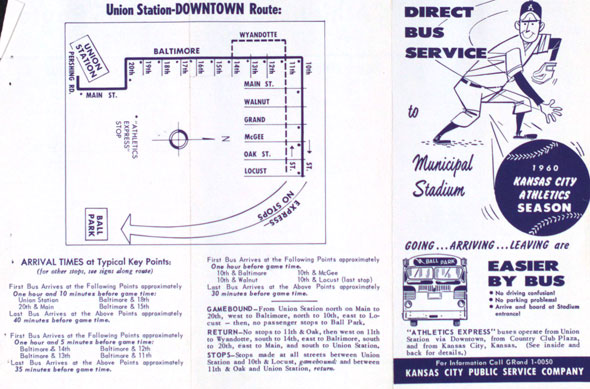
As part of their fact-finding missions, Toronto sent questionnaires to the municipal governments of 19 American cities with their own franchise. Most responded with intricate details of average spends, pedestrian traffic figures, and gorgeous maps of their cities. Based on the facts gleaned from this survey, the city established its own set of stadium criteria.
It a nutshell, it needed to accommodate baseball, football, and other "sundry" sports, a horseshoe or bowl shape, have links to a subway and highway, and be able to hold 60,000 fans. The total cost was predicted to be between $3- and $6-million, depending on the location.
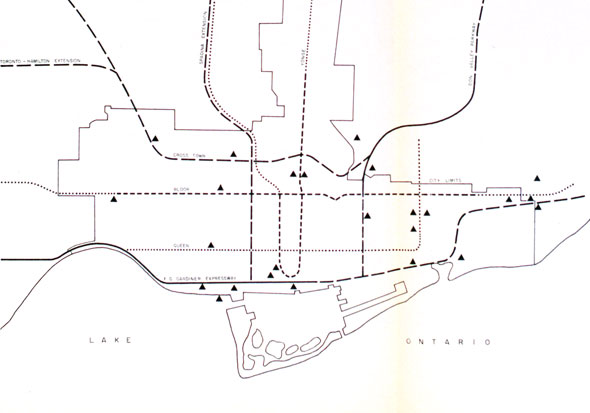
Major League Baseball had indicated it planned to expand the American League in 1960 into cities without a team of their own. It's likely plenty of towns in the US sent in applications - an MLB franchise was widely seen as a major boon to local economies. Toronto's formal proposal imagined a team named the "Toronto Canadians" that would play in a purpose-built stadium somewhere in the city and attract visitors from the US.
The pitch tried to dispel concerns about the local climate (ironically, the Jays' first game would be played on a snowy field) and boasted of Torontonians love for the bat and ball. You can read the whole thing below:
Meanwhile, in an internal report, the city weighed the pros and cons of various stadium locations. Very few open spaces were exempt from at least some kind of consideration and as a result several truly awful proposals came up (a Skydome in Trinity Bellwoods Park, anyone?)
The locations that didn't make it beyond the first elimination were: High Park, Earlscourt Park, Christie Pits, Dentonia Park, Ramsden Park, the air directly above rail yards at Hillcrest and Main Street and Danforth, Woodbine Racetrack and several other sites in East York, Scarborough, and Toronto. A few, upon study, merited more detailed proposals. Here are some of those:
GREENWOOD AVENUE
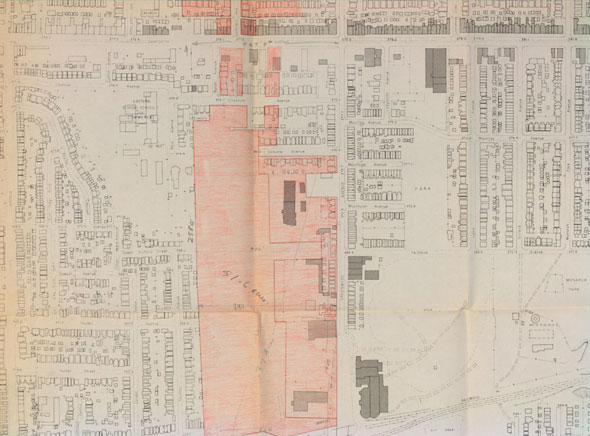
In late 1950s, two large patches of land either side of Greenwood Avenue just south of the Danforth was up for grabs. Disused gravel pits, roughly where Monarch Park and St. Patrick Catholic Secondary School stand today were listed as suitable for a major league ballpark.
On the west side of the street, the TTC lands which had yet to be developed into a subway yard were also thought ripe for development. The city pitched the idea of a stadium above the subway yard with a spur line or second exit into the complex from the planned Greenwood station. Alternatively, parking would have been placed over the yard and a pedestrian bridge across Greenwood Avenue would link to a stadium in Monarch Park. The city balked when the TTC said an engineering study would be cost prohibitive.
CENTRAL HARBOURFRONT
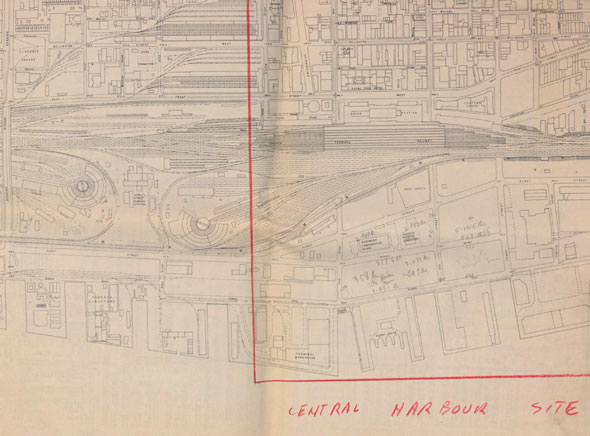
One of two waterfront proposals, the planned stadium would have been built on existing fill south of Queens Quay between York and Yonge, the site of the present day ferry terminal. Good links to the Gardiner Expressway, Union Station, and the downtown core were considered major positives. The report suggested using the stadium's parking for nearby offices in the off-season. The plan was nixed because it was thought ramps to the highway would be too close.
KING-JOHN-FRONT-SIMCOE
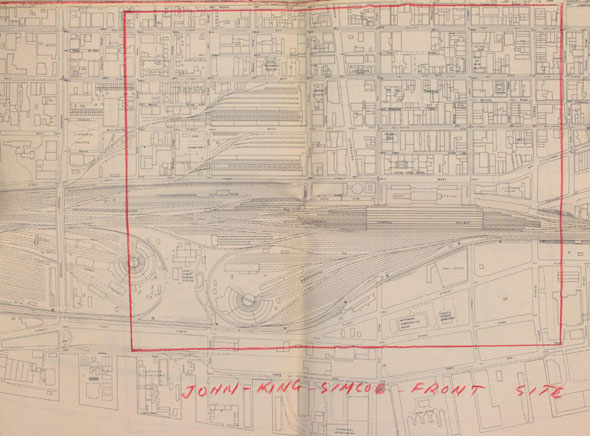
Foreseeing the reduction in railway use in the area, a stadium was planned to cover the area south of King north of Front, effectively condemning part of Wellington Street to pass through a tunnel.
Though it had good transit connections, the idea of a stadium here wasn't considered viable due to its potential impact on local traffic. An alternative site roughly where the CN Tower is now is also mentioned but the cost of building over the tracks was thought to be prohibitive.
MAPLE LEAF STADIUM
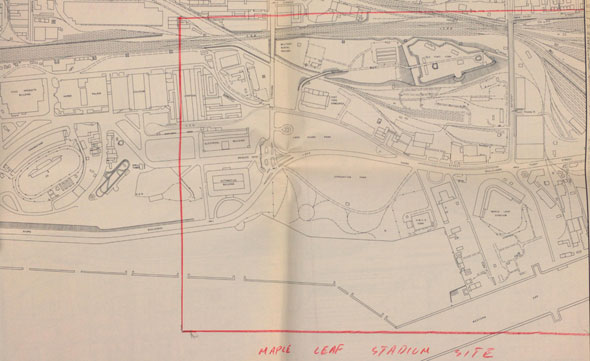
Refurbishing the former home of the bat and ball Toronto Maple Leafs made a good deal of sense. The site was big enough to accommodate expansion, the ballpark was already established, and there was a good chance of building links to the proposed Queen Street subway and the Gardiner Expressway.
What the Lake Shore Boulevard lacked, however, was parking. This was the 1950s and the car was the king. The nearest available land would have required (shock horror) a shuttle bus service. The proposal also suggested a rapid transit link to Union Station but died on the table. The stadium site is now occupied by apartments.
LAKE ONTARIO
This one was probably the most ridiculous of all the stadium suggestions. Basically a proto-Ontario Place, the stadium in the lake would have required new fill close to the Western Gap against the advice of the Harbour Commission who wanted the space between the city and Billy Bishop airport open.
Unfortunately for render junkies the stadium didn't progress the diagram or mock-up stage. The massive cost of building a new stadium in the lake was the main reason why this project never garnered popular support.
RIVERDALE PARK
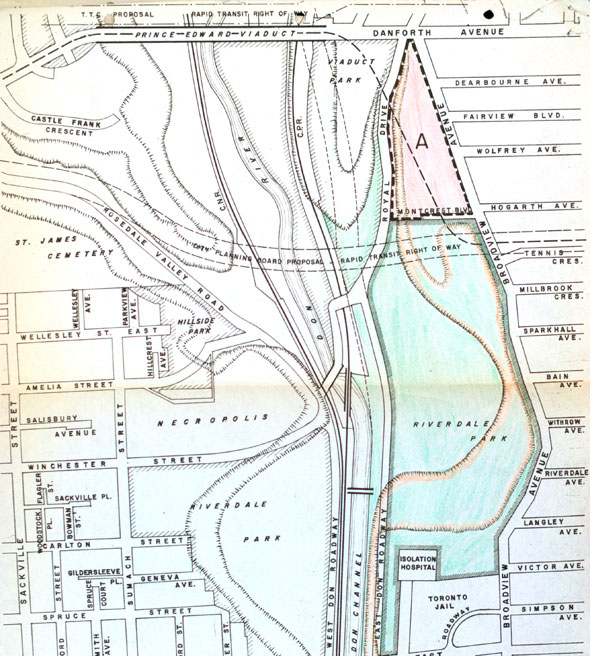
Believe it or not, this was actually the city's favoured location for the Toronto Canadians. The natural amphitheatre in the land north of the isolation hospital lent itself well to baseball and the links to the coming Bloor-Danforth line and Don Valley Parkway were a major draw for developers.
It's worth noting that the route for the subway hadn't been finalized in the above map and two possible alignments are shown: one over the Prince Edward Viaduct and one under the Don Valley further south. Had a stadium been approved for Riverdale Park it's possible the route of the Bloor-Danforth line could have been altered to accomodate the project.
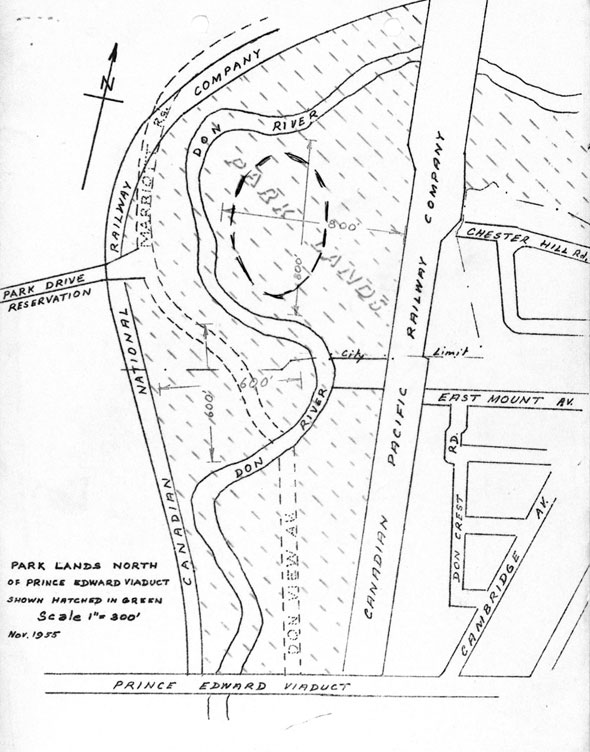
An alternative site north of the Prince Edward Viaduct on the valley floor would have linked to the Danforth by a system of escalators and required a the diversion of the Don River.
During examinations it was decided that the land in the valley would have to be raised before construction could begin to prevent disaster in the event of a flood. Hurricane Hazel just a few years before had clearly demonstrated the dangers of building too close to rivers and the associated costs of keeping the stadium safe was likely a deciding factor when it came to eliminating this location.
ROSEDALE
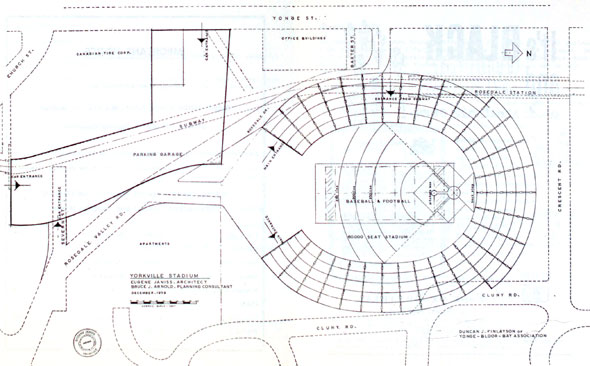
Hoards of marauding baseball fans in one of the city's most upscale neighbourhoods? Sure, why not. The "ingenious" Rosedale Stadium was sketched at the top of Rosedale Valley Road directly over the top of the subway station and seemed to have some local support.
A 5,000-space parking lot close by would have served the stadium on game days and, apparently, boosted local shopping. The natural bowl shape in the land at the top of the valley would have allowed the ballpark to be submerged below the level of the surrounding neighbourhood in an attempt to cut noise.
One pamphlet distributed at the time by the Yonge-Bloor-Bay Association makes a passionate case for the project but then continues to state, bizarrely, that "there is not much place in society for beatniks."
EXHIBITION PARK
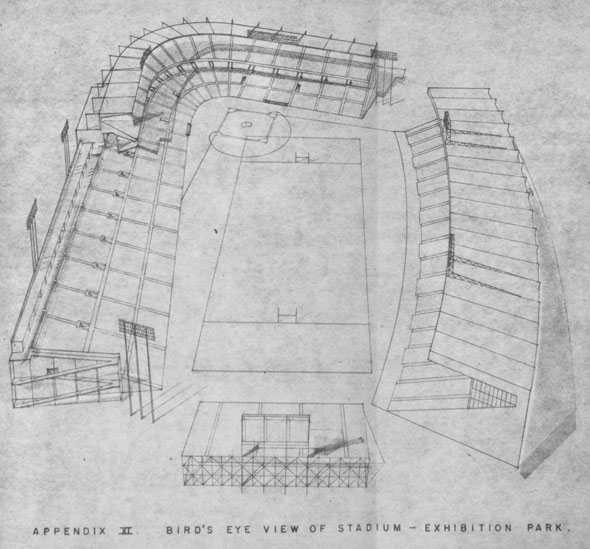
Another stadium reno, the CNE grounds proposal suggested boosting capacity at the existing Exhibition Stadium as an economy measure compared to the cost of building a new arena on reclaimed or flood-prone land.
The report worried about scheduling clashes with football games and other Ex events but later it was agreed the stadium could get almost as much money from hosting Grey Cup games as MLB matches. The transit links weren't ideal though - just two streetcar lines served the site and the chances of a hookup to a subway line weren't great.
Though it wasn't the favourite, Exhibition Stadium was eventually selected as the site for the proposed new franchise. A south bleacher section was added in 1959 but, in the end, it was all for naught. MLB didn't feel like playing ball with Toronto or Canada at that time. The new franchises were awarded to the Los Angeles Angels and Washington Senators (now Texas Rangers).
The city would have to wait another 16 years for the Blue Jays to land at the CNE grounds.
Images: City of Toronto Archives
Latest Videos
Latest Videos
Join the conversation Load comments







